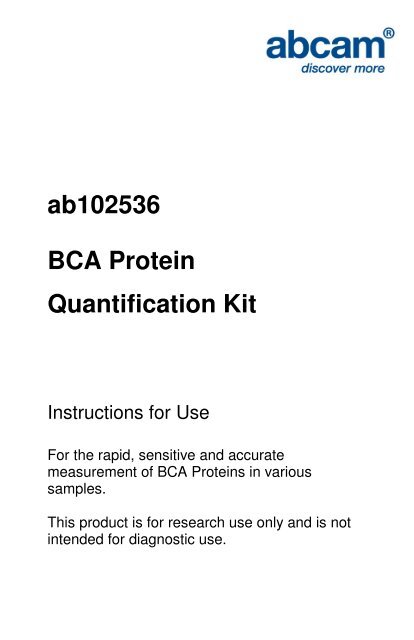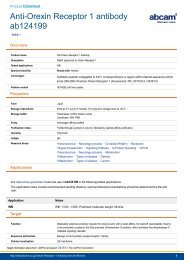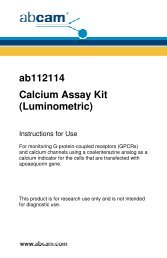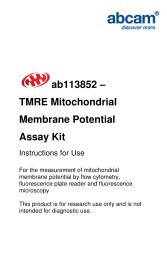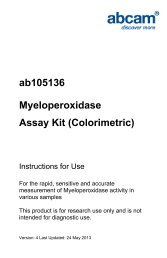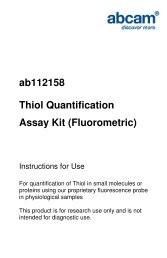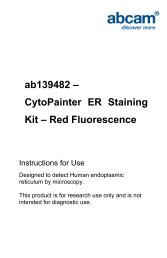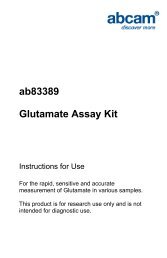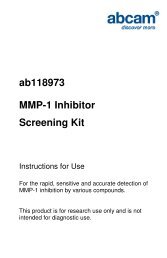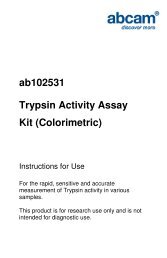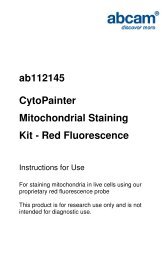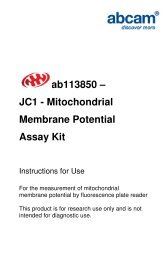ab102536 BCA Protein Quantification Kit - Abcam
ab102536 BCA Protein Quantification Kit - Abcam
ab102536 BCA Protein Quantification Kit - Abcam
You also want an ePaper? Increase the reach of your titles
YUMPU automatically turns print PDFs into web optimized ePapers that Google loves.
<strong>ab102536</strong><strong>BCA</strong> <strong>Protein</strong><strong>Quantification</strong> <strong>Kit</strong>Instructions for UseFor the rapid, sensitive and accuratemeasurement of <strong>BCA</strong> <strong>Protein</strong>s in varioussamples.This product is for research use only and is notintended for diagnostic use.
Table of Contents1. Overview 32. Protocol Summary 33. Components and Storage 44. Assay Protocol 55. Data Analysis 76. Troubleshooting 82
1. Overview<strong>Abcam</strong>'s <strong>BCA</strong> <strong>Protein</strong> <strong>Quantification</strong> <strong>Kit</strong> provides a simple, rapid,detergent tolerant (up to 5%) procedure for determining theconcentration of proteins in solution. The method utilizes a copper(Cu 2+ ) salt which can be reduced to the cuprous state by protein(s).The generated Cu 2+ ion forms an intensely colored complex with thebicinchoninic acid reagent with a very strong absorbance bandcentered at 562 nm. The intensity of the blue complex is proportionalto the amount of protein in the sample. The <strong>BCA</strong> <strong>Protein</strong> Assay issuitable for measuring protein concentration in the range of0.5-30 µg protein (0.01-0.6 mg/ml).2. Protocol SummaryReagent PreparationStandard Curve PreparationAdd Working Solution to Samples and StandardsIncubate for 30-90 MinutesMeasure Optical Density3
3. Components and StorageA. <strong>Kit</strong> ComponentsItemQuantity<strong>BCA</strong> Reagent100 mLCopper Reagent2 mLBSA Standard (10 mg/ml)1 mL* Store kit at +4°C. The <strong>BCA</strong> and Copper Reagents are stable atroom temperature. The BSA Standard should be aliquoted after thefirst thaw and stored at -20°C. All reagents are stable for up to12 months under proper storage conditions.B. Additional Materials Required• Microcentrifuge• Pipettes and pipette tips• Colorimetric microplate reader• 96 well plate• Orbital shaker4
4. Assay ProtocolNotes:a) The <strong>BCA</strong> protocol is very flexible. Both the incubation time andtemperature can be varied over a rather wide range. Lowerprotein samples can be more easily quantified using highertemperatures and longer incubation times.b) When assaying protein in solutions containing detergent, bestresults are obtained by adding the same amount of detergent tothe wells containing the protein standard.1. Reagent Preparation:Prepare Working Solution by adding 1 part of Copper Reagent to50 parts of <strong>BCA</strong> Reagent. The total volume made will depend uponthe number of samples and standards to be quantitated. Eachsample and standard will require 100 µl of working reagent. Oncemade, the Working Solution is stable for several days.2. Standard Curve Preparation:Label 8 tubes 1-8. Dilute the BSA Standard to 1 mg/ml StockSolution (i.e., 40 µl + 360 µl buffer). Ideally, use the same buffercontained in your samples.Transfer 200 µl from tube 8 to tube 7. Then prepare serial dilutionsas in Table 1.5
Table 1. Serial DilutionsTube BSA Solution (µl) Buffer(µl) 50 µl =8 Stock Solution (256) 144 32 µg7 Tube 8 (200) 200 16 µg6 Tube 7 (200) 200 8 µg5 Tube 6 (200) 200 4 µg4 Tube 5 (200) 200 2 µg3 Tube 4 (200) 200 1 µg2 Tube 3 (200) 200 0.5 µg1 --- 200 0 µg3. Dilute samples to fall within 0.01-0.6 mg/ml range.4. Pipette 50 µl Standards or samples into duplicate wells in a clearbottom 96 well plate.5. Add 100 µl of Working Solution into each well that contains thestandard or samples.6. Shake gently to mix. Incubate for between 30-90 min at 37-60°C.Cool to room temperature.7. Measure OD at 562 nm. The signal is stable for at least 1 hour.For unknown samples, several dilutions of a sample should betested to ensure the OD reading is within the standard curve range.6
5. Data AnalysisSubtract the blank OD (zero standard) from all standard and sampleOD values. Plot the corrected OD against standard proteinconcentrations. Use the standard curve to determine the sampleprotein concentration.Alternatively, the equation for the best line fitting the standards canbe used to determine the protein concentration of your samples.Standard curves carried out according to assay protocol.7
6. TroubleshootingProblem Reason SolutionAssay notworkingUnexpectedresultsAssay buffer atwrong temperatureProtocol step missedPlate read atincorrect wavelengthUnsuitable microtiterplate for assayMeasured at wrongwavelengthSamples containimpeding substancesUnsuitable sampletypeSample readings areoutside linear rangeAssay buffer must not be chilled- needs to be at RTRe-read and follow the protocolexactlyEnsure you are usingappropriate reader and filtersettings (refer to datasheet)Fluorescence: Black plates(clear bottoms);Luminescence: White plates;Colorimetry: Clear plates.If critical, datasheet will indicatewhether to use flat- or U-shapedwellsUse appropriate reader and filtersettings described in datasheetTroubleshoot and also considerdeproteinizing samplesUse recommended samplestypes as listed on the datasheetConcentrate/ dilute samples tobe in linear range8
Problem Reason SolutionSampleswithinconsistentreadingsLower/Higherreadings insamplesandstandardsUnsuitable sampletypeSamples prepared inthe wrong bufferSamples notdeproteinized (ifindicated ondatasheet)Cell/ tissue samplesnot sufficientlyhomogenizedToo many freezethawcyclesSamples containimpeding substancesSamples are too oldor incorrectly storedNot fully thawed kitcomponentsOut-of-date kit orincorrectly storedreagentsReagents sitting forextended periods oniceIncorrect incubationtime/ temperatureIncorrect amountsusedRefer to datasheet for detailsabout incompatible samplesUse the assay buffer provided(or refer to datasheet forinstructions)Use the 10kDa spin column(ab93349)Increase sonication time/number of strokes with theDounce homogenizerAliquot samples to reduce thenumber of freeze-thaw cyclesTroubleshoot and also considerdeproteinizing samplesUse freshly made samples andstore at recommendedtemperature until useWait for components to thawcompletely and gently mix prioruseAlways check expiry date andstore kit components asrecommended on the datasheetTry to prepare a fresh reactionmix prior to each useRefer to datasheet forrecommended incubation timeand/ or temperatureCheck pipette is calibratedcorrectly (always use smallestvolume pipette that can pipetteentire volume)9
Standardcurve is notlinearNot fully thawed kitcomponentsPipetting errors whensetting up thestandard curveIncorrect pipettingwhen preparing thereaction mixAir bubbles in wellsConcentration ofstandard stockincorrectErrors in standardcurve calculationsUse of otherreagents than thoseprovided with the kitWait for components to thawcompletely and gently mix prioruseTry not to pipette too smallvolumesAlways prepare a master mixAir bubbles will interfere withreadings; try to avoid producingair bubbles and always removebubbles prior to reading platesRecheck datasheet forrecommended concentrations ofstandard stocksRefer to datasheet and re-checkthe calculationsUse fresh components from thesame kitFor further technical questions please do not hesitate tocontact us by email (technical@abcam.com) or phone (select“contact us” on www.abcam.com for the phone number foryour region).10
UK, EU and ROWEmail: technical@abcam.comTel: +44 (0)1223 696000www.abcam.comUS, Canada and Latin AmericaEmail: us.technical@abcam.comTel: 888-77-A<strong>BCA</strong>M (22226)www.abcam.comChina and Asia PacificEmail: hk.technical@abcam.comTel: 108008523689 ( 中 國 聯 通 )www.abcam.cnJapanEmail: technical@abcam.co.jpTel: +81-(0)3-6231-0940www.abcam.co.jpCopyright © 2012 <strong>Abcam</strong>, All Rights Reserved. The <strong>Abcam</strong> logo is a registered trademark. 11All information / detail is correct at time of going to print.


